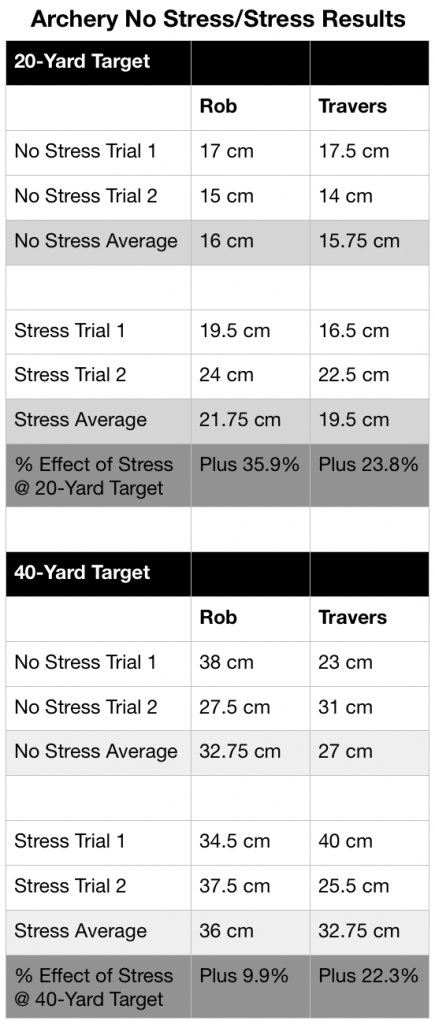
By Rob Shaul
BLUF
This mini-study investigated the effect of stress on archery accuracy and found that a simple stress event which applied a small fitness demand and shot time limit decreased archery accuracy by an overall average of 23% for two subjects.
BACKGROUND & STUDY DESIGN
Previously, MTI has done extensive work on stress marksmanship using firearms, including the development “Range Fitness,” a system to train stress marksmanship for carbines and pistols. We’ve also conducted several marksmanship studies including the effect of dry fire practice on marksmanship, the effect of airsoft practice on marksmanship, and the effect of lighter trigger pull on marksmanship.
Somewhat surprisingly, given our extensive work in developing the Range Fitness system, we never actually tested the effect of stress on marksmanship … until now, and with archery.
In a bowhunting context, marksmanship under stress is a major concern. Every shot on game includes significant stress for all but the most seasoned hunter, and several bowhunters report suffering from “target panic.”
This mini-study tested the effect of stress on archery marksmanship over two shooting distances, 20 yards, and 40 Yards.
Two experienced bowhunters shot two no-stress, and two stress trials from each distance (20 yards and 40 yards) for a total of8 trials.
Three arrows were shot each trial, one each from standing, kneeling and sitting position. The same three arrows were used for each trial.
For the No-Stress trials, the subjects were allowed to shoot their arrows without a time limit and while rested.
The Stress Trials applied two stressors, a 30 second time limit, and the shooters were caused to run a 40 yard shuttle sprint prior to shooting. The 30 second time limit included both the shuttle and the shot. Shooters had a 30-second rest between shots from different positions during the stressful events. Here is the event.
-
- Subject stands ready with arrow knocked.
- 30 Second Time Limit. 9″ Round Target.
- On “Go” Subject runs down 20 yards, and back 20 yards, then gets into the shooting position for that specific shot (standing, kneeling or sitting) and releases his arrow before the 30 seconds is up.
- He then has 30 seconds rest to knock another arrow, and beginning the shuttle for the shot from the next shooting position.
The short clip below shows Travers complete one of his stress shots at 40 yards:
Three arrows were shot for each trial, a metric fabric measuring tape was strung around the outside of all three arrows, and the total circumference in centimeters used to measure accuracy.
The average circumference for the No-Stress and the Stress trials was then calculated, then compared to identify the effect of stress on marksmanship.
RESULTS & DISCUSSION
Below are the mini-study results:

We understand this mini-study has a small subject size (2) and it should be understood that small sample size likely skews the results. Regardless, the results were interesting in the consistency of direction and extent from the effect of stress.
Stress certainly has an effect on accuracy given the consistency demonstrated by the poorer shooting by both subjects at measurement distances.
From the results chart, “Plus 35.9%” means Rob’s 3-arrow average group circumference under stress at 20 yards was 35.9% larger than his 3-arrow average group circumference during the no-stress trials at 20 yards, or he was 35.9% less accurate. This is a significant decrease in accuracy.
Overall, both subjects at both distances shot 23% less accurate 3-arrow groups during the stress trials than the no-stress trials.
NEXT STEPS
The stress event deployed in this trial put two stressors on the shooters, a fitness/physical stressor (shuttle), and a time limit (30 seconds) to great effect. Moving forward, it would be instructive to conduct this mini-study on a much larger sample size of archers to see if the trend and results remain the same or similar.
Likewise, conducting a similar study using firearms and paper targets, or firearms and counting hits on metal targets would be valuable. We’ve seen firearm studies which assessed the stress on firearm shooters from CQB training and other events, but none which systematically tested the effect of stress on accuracy.
Questions, Comments, Feedback? Email rob@mtntactical.com
You Might Also Like Study: Moderate Stress Significantly Impacts Marksmanship
